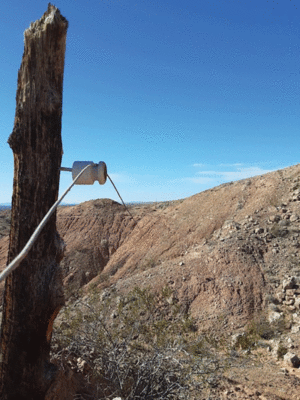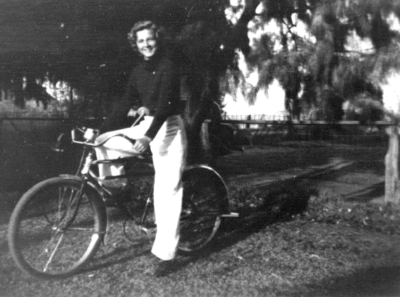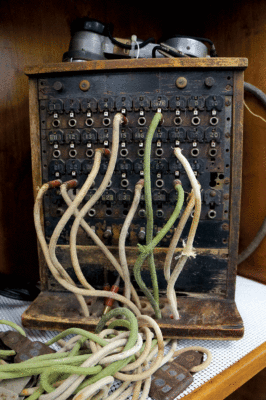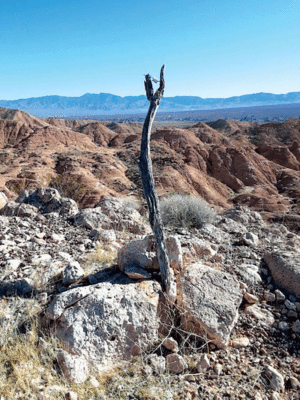By CHERYL JENSEN
The Progress

Nowadays it is easy to reach out and touch someone. With the proliferation of cellphone technology, many households don’t even bother having a landline telephone. So it is easy to forget what wonder and a novelty it was to have early telephone technology in the Virgin Valley community. This is a brief, but thorough history of the beginnings of the Rio Virgin Telephone system.
A small telephone system in Mesquite was first started around the turn of the 20th century by Hubert A. Leavitt. Later he got enough wire and materials to connect over to Bunkerville and up to Littlefield, Arizona.
Local communication at this level was considered a great thing. But a long-distance line was still needed when an emergency arose, in order to be able to reach a doctor in St. George fifty miles up over Utah Hill.
Hubert started out riding his horse dragging poles from the river slew and stringing baling wire, barbed wire or any kind of wire he could get. People would joke that the ladies would take down their clothes line when not in use to prevent “Old Huber” from swiping the wire for the telephone system.
July 10, 1908, the other communities were visited for the purpose of soliciting information and subscriptions in the erection of a telephone line from Moapa to St. George. Edward Bunker visited E. H. Snow in St. George and was given “much encouragement to the proposition.”

They wanted to gather cottonwood poles of sufficient size and obtain wire and glass insulators. The other company in Washington County would give them rates over their lines and accept the rates over the ones in the Virgin Valley. The people in Littlefield wanted to be on the line also. The minutes of that meeting said the motion was passed to build a line from Moapa to St. George.
On July 17, the first meeting of the Rio Virgin Telephone company was held. William E. Abbott was elected president and business manager. James S. Abbott was secretary/treasurer and Joseph H. Reber was appointed as director. The limit of capital stock was set at $1,000. Shares were offered with a par value for $10 each with subscription to be paid to the office on or before September 1.
The company wanted to procure pine poles for the line through the town and cottonwood poles other places. They would pay 10 cents each provided they were not less than 13 feet long, 3 inches at the top end and straight. Laborers were hired to put in the line and were paid $1.50 per day. They had to board themselves.

There were places the post holes could not be dug deep enough because of the hard, rocky ground. So the crews would dig as deep as possible and then build up around the pole with rocks and dirt to hold it in place.
They wanted to take some of the capital start money and run a branch line to the raisin farm and Mr. Reber would pay $10/month for the use of the line.
In the minutes of the February 15, 1909 meeting, E. H. Snow of St. George said they would run their own line and would not need poles and frames for that purpose. The people there would furnish 400 poles to run from the point this way up to the timber on the mountain.
Hubert A. Leavitt reported his labor in gathering poles in Mesquite and had 40 poles. Bunker urged the setup of the poles as fast as possible.
In a 1910 meeting, the stock was set at $10 per share and fees were set at $2.00 per month for the telephone service. If you were a member, the fee was $1.50; and only $1.00 per month if you took a turn to operate the switchboard.
The $10 stock money would be used for repairing and extending the line. In the minutes of the meeting the question of uniting the phone companies of Muddy Valley and St. George was brought up but nothing was settled at that date.
 One of the main reasons they wanted a phone line was to call for medical help from St. George. The only means of getting medical assistance, other than what the local people might render, was by horseback which took six hours or more of hard riding to get to the doctor in St. George and six more hours back. By then it might be too late.
One of the main reasons they wanted a phone line was to call for medical help from St. George. The only means of getting medical assistance, other than what the local people might render, was by horseback which took six hours or more of hard riding to get to the doctor in St. George and six more hours back. By then it might be too late.
In 1916 a number of people including Grandpa Bowler, Bert Truman, John Bowler of Gunlock, Henry Holt of St. George and others organized the People’s Progressive Telephone Company and built a line from St. George through Littlefield, Mesquite and on to the Moapa railroad station where it was connected with Western Union.
J.D. Pulsipher had purchased several miles of No. 9 iron wire from the Desert Telegraph line which was built in Utah about 1870. He intended to use it for fencing the first enclosures in Mesquite. But the intrepid Hubert had other plans. His fencing was soon being talked “over” instead of talked “about.” Pulsipher then became the holder of a block of stock in the company.
Lewis Pulsipher furnished forty miles of BB No. 12 phone wire to construct the line. There was an understanding that, when the wire was purchased, he would be repaid in cash. However, when the company wasn’t able to pay for it, they issued him stock in the company instead.
Pulsipher could ill afford such an investment. But he had no other choice and all of the members of the community were anxious to get the new line put in place. The phone line was instrumental in saving lives, in marketing farm products and exchange of news.
In 1917 Pulsipher, the largest stockholder, purchased more stock and operated the line from Moapa to St. George. The line was then extended to Pine Valley, Pinto and Enterprise.
The report to the Public Utilities Commission shortly after it was formed makes great reading. Under officers the report read, “None elected in nine years.” Grand total assets, “None.” Grand total Liability, “None.” Operating revenue is listed for one year as a total of $30. In the space left for the notary public to make it official the report reads, “no notary public within 43 miles.”
The company eventually divided and Mesquite began to operate its own part of the line from St. George to Moapa. Nancy Bowler became the operator.
In 1922 Pulsipher hired Vie Hancock and Lawrence Leavitt and they re-built the line from St. George to Moapa. Lewis’ wife, Marian, became the central switchboard operator and worked from her home. They operated the telephone exchange for almost twenty years with almost primitive first instruments. They used an old crank generator and grounded-line circuit.
When messages came from outside of the area, the information was written down and delivered. Western Union telegrams from the Moapa train station were read over the phone and written on the yellow papers provided. Hazel Pulsipher, his daughter, would hop on her bike, ride to a house and deliver a message for a fee of 10 cents. The person would come down and use the outside telephone to make a call if they did not have a phone in their home. Hazel also spent a lot of time at the switchboard as her mother was carrying for her brother who was blind.
Hazel’s daughter Geraldine recalled that most of the calls were made from outside the area or calls were made to St. George for medical help.
“In those days, if you wanted to talk to friends and neighbors, you just got on your horse and rode over for a visit,” said Geraldine.
“Everyone was on a party line and each had a special ring to know if they should answer,” Geraldine adds. “If you were very quiet and careful you could listen in on your neighbor’s conversation if you knew the ‘ring’ for their phone.’
Lewis’ sons were raised on the jangling tune of the old-fashioned crank-handle wall type phone.
About 1940 James Pulsipher, Lewis’ brother, purchased the telephone system and moved all of the equipment from Lewis’ living room to what used to be the egg co-op house where farmers brought their eggs to sell in Las Vegas. Pulsipher’s wife Rita became a switchboard operator. There were now 77 outlets.
In March 1954, Mike Burns purchased one-half interest in the Rio Virgin Company. It was incorporated and by July 21 there were over 300 outlets with 90 percent of the houses having phone service.
It took seven months to convert the system to dial telephones with all new equipment and lines installed. James N. Pulsipher and Mike Burns, owners, invested $125,000 to make the new system become reality.
The company purchased equipment from Stromberg-Carlson – the very latest type from the non-breathable plastic phone to the 23X wet-cell batteries hooked in series to automatically supply power if the other source failed.
Robert Blewett, was hired to install 500 miles of new copper line, with three carloads of extra poles and 300 new “drops” and terminals. Blewett remained as the general manager and engineer.
Wayne Persline was in charge of installation of the dial board that was installed in a new dustproof air-conditioned building. Persline was excited to have a ten-party single line on which one phone would ring at a time. It was called divided ringing and no other manufacturer had this modern equipment.
The company also added an “out of service” tape recording. Before that, if you called you had no way of knowing if the line was broken or the phone was out of order.
J. Lewis Pulsipher made the first call on the new system at 10:00 am. on July 21. The public was invited to be at the ceremonies and hear his call to his sons in Salt Lake City. Eighty-seven-year-old Elizabeth Pulsipher, former operator, was also on the line to say hello.








![ElectionAd [Recovered]2](https://mvprogress.com/wp-content/uploads/2024/05/4-24-2024-FC-ElectionAd-Finalv3.jpg)

